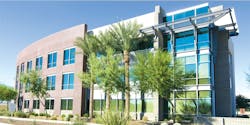‘Expert in a Suitcase’ Provides Energy-Saving Solution
Researchers from the Pacific Northwest National Laboratory (PNNL) and Lawrence Berkeley National Laboratory have found a way to pack big savings into a small package – the size of a suitcase.
The Sensor Suitcase, which has now been licensed for use to two companies in the U.S., is a portable case with sensors and equipment designed to identify energy efficiency deficiencies and opportunities in a building. The system combines hardware and software in one package for building operators to find energy solutions for small commercial buildings.
“Most small commercial building owners believe it costs too much to make their facilities significantly more energy-efficient,” says scientist Michael Brambley, leader of PNNL’s development team. “But the Sensor Suitcase system can change that. It helps someone with minimal training collect and automatically process building data, which the system uses to generate specific recommendations to improve energy efficiency. The U.S. could reduce its national energy costs by about $5.1 billion if all small commercial buildings used this technology.”
In the past, small commercial buildings have often been unable to implement technologies that improve energy efficiency at this level.
“The real innovation is in the streamlining,” says mechanical engineer Jessica Granderson, leader of Berkeley Lab’s development team. “It’s kind of like the ‘for dummies’ version of how to identify improvements in your building. Instead of hiring a professional engineer to conduct a full energy evaluation, you could get just about anyone to do it.”
Simplifying Retro-Commissioning
The Sensor Suitcase is designed for retro-commissioning existing buildings to improve how they operate. Unlike larger commercial buildings that can be more easily retro-commissioned, the process is often cost-prohibitive for buildings smaller than 50,000 square feet. The suitcase should help some FMs in smaller commercial buildings overcome this.
The suitcase includes 16 pocket-sized sensors that measure temperature, whether lights are on or off and how HVAC systems are operating. Installation of these sensors is explained in the Sensor Suitcase’s operations software, and a month later, users put the sensors back into the suitcase. Users then connect the sensors to a computer where software analyzes the data, thereby eliminating the need for a professional to decipher it.
This culminates in a report that finds problems, suggests cost-effective solutions and provides estimated cost savings for addressing these problems.
The Sensor Suitcase can help FMs save about two-thirds of the energy that can be saved with the typical retro-commissioning process, and it eliminates the labor and duration of time it takes to set it up.
The Sensor Suitcase is already licensed to two companies who plan on selling its technology in their products. However, both licenses are non-exclusive, so the technology will be available for other companies moving forward.
